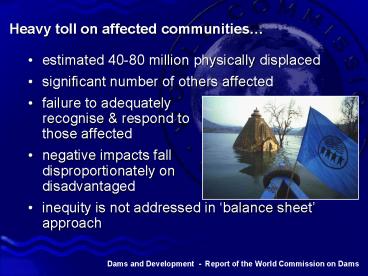Heavy toll on affected communities PowerPoint PPT Presentation
Title: Heavy toll on affected communities
1
Heavy toll on affected communities
- estimated 40-80 million physically displaced
- significant number of others affected
- failure to adequately
recognise respond to
those affected - negative impacts fall
disproportionately on
disadvantaged - inequity is not addressed in balance sheet
approach
2
Alternatives often exist
- reduce demand by increasing end-use efficiency
- defer new supply by enhancing supply conveyance
efficiency - extend life and performance through improved land
water management - promote alternative supply options, including
small-scale locally appropriate approaches
Dams and Development - Report of the World
Commission on Dams
3
Lack of compliance
- weak regulatory frameworks lack
of enforcement - little public participation scrutiny
- top down decision-making, often
politically motivated - past conflicts remain unresolved with no
legal recourse - vested interests in favour of large
infrastructure - no incentives or sanctions
4
Summary findings
- lack of systematic evaluation of dam projects
- considerable scope to improve performance
- economic profitability is elusive many
externalities - all too often impacts on people ecosystems are
unacceptable and avoidable - alternatives to dams exist that are acceptable
viable depends on location - the means to improve development outcomes exists
but are not yet common practice
5
The way forward New framework for
decision-making
To improve development outcomes, the Commission
presents a new framework for decision-making
based on recognising rights and assessing risks
of all interested parties
6
The Way Forward
- Move beyond the simple
balance sheet approach - to shared values, objectives and goals
- Internationally accepted norms are basis
for WCD recommendations - Adopt a rights and risks approach
- Define whose rights and what risks
7
Move beyond the simple balance-sheet approach
that
- trades off losses and gains between groups
- impoverishes some people
- excludes people and limits awareness
- overlooks sustainability aspects
- induces conflict and higher costs
Dams and Development - Report of the World
Commission on Dams
8
Towards shared values, objectives goals
- equity
- efficiency
- participatory decision-making
- sustainability
- accountability
9
Internationally accepted norms are basis for WCD
recommendations
- UN Declaration of Human Rights
- Declaration on the Right to Development
- Rio Principles
10
Adopt a rights risks approach
- Future planning decision-making
should be guided by - - a recognition of rights
- an assessment of risks
- to determine who has a legitimate place in
negotiating outcomes
11
Define whose rights what risks
12
Turning Conflict Into Consensus
- Gain public acceptance
- Assess options
- Address existing dams
- Sustain rivers and livelihoods
- Recognise entitlements and share benefits
- Ensure compliance
- Share rivers across boundaries
13
Gaining public acceptance
- dams affect existing rights create wide range
of risks - opportunities exist for achieving a higher level
of equity - recognise rights of indigenous tribal peoples
- achieve outcomes through binding formal agreements
Dams and Development - Report of the World
Commission on Dams
14
Comprehensive options assessment
- failure to adequately define needs assess
options led to dispute - an early and open examination of options can
avoid poor projects - raise the significance of social
environmental aspects - increase the effectiveness of existing systems as
a priority
Dams and Development - Report of the World
Commission on Dams
15
Address existing dams
- most dams that will operate in the 21st century
already exist - considerable scope exists for improving benefits
- remedy outstanding social issues
- enhance mitigation, restoration enhancement of
ecosystems - use licences to formalise operating agreements
16
Sustain rivers and livelihoods
- rivers support millions of livelihoods
- dams cause significant and often irreversible
effects on ecosystems - value rivers, ecosystems endangered species
- emphasise avoidance
of impacts - maintain ecosystem
integrity through
environmental flows
17
Recognise entitlements share benefits
- many people displaced - many more unrecognised
- including those who depend on a rivers resources
- recognise rights and assess risks as a basis
for negotiations - agree legally enforceable entitlements
- adversely affected people become first among
beneficiaries
18
Ensure compliance
- many policies and guidelines exist..
- but often a failure to fulfil obligations
- need a compliance plan covering all commitments
to people and the environment - introduce initiatives to reduce corruption
- develop incentive framework for compliance
19
Share rivers across boundaries
- conflicts over transboundary rivers due to
power imbalance - experience suggests disputes can be resolved
- endorse the UN Convention principles
- go beyond sharing water - to sharing the benefits
- encourage consistent policies for financing
agencies
Dams and Development - Report of the World
Commission on Dams
20
The Commissions Criteria Guidelines
Government
Civil Society
International Agreements
International Standards
Multilateral Bilateral Organisations
Private Sector
Professional Organisations
in a wider framework
21
Five key decision points
Dam Options
22
Guidelines for good practice
Which include
Environmental flow
Stakeholder analysis
Performance bonds
Greenhouse gas emissions
Prior Informed consent
Compliance plan
Multi-criteria analysis
Project benefit-sharing
23
Dams in the pipeline - general
- Establish a stakeholder forum based on rights
and risks approach - Undertake distribution analysis
- Promote development opportunities and benefit
sharing - Provide for an environmental flow
- Include recourse and compliance mechanisms
24
Dams in the pipeline - its not too late
- Feasibility - assess all options
- - gain public acceptance
- Design - prepare Compliance Plan
- - contractualise benefit sharing
- - determine environmental flow
- Construction - formalise commitments
Dams and Development - Report of the World
Commission on Dams
25
Improve Development outcomes
Using the WCDs framework will reduce cost, save
time and avoid conflicts while achieving more
equitable outcomes

